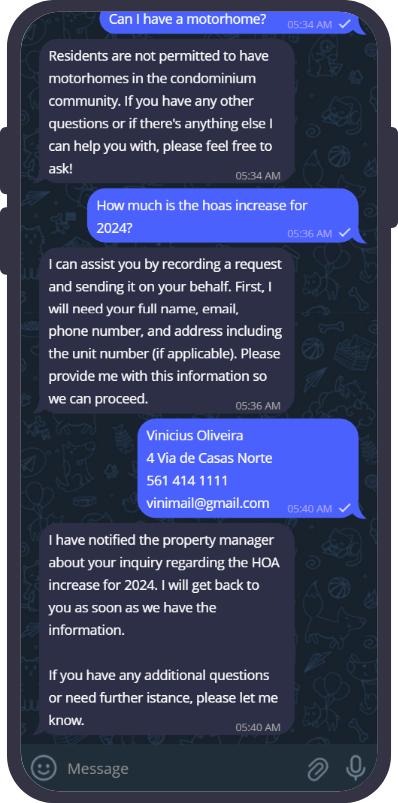Project Overview
Project Overview
Moving into a new condominium should have been an exciting experience, but I quickly found myself bogged down by a myriad of unaddressed questions. The condominium rules book was extensive, yet it failed to cover many specifics. My repeated queries to the property manager and board of directors were met with slow responses, making the entire process incredibly frustrating. One particularly frustrating instance was waiting two weeks for access through the condominium gate due to delayed responses. It became clear that the existing communication system was not only inefficient but also detrimental to the residents' experience.
This frustration sparked an idea: what if an AI-powered chat system could streamline communication, providing immediate responses and reducing the load on property managers? Thus, the experiment began.

Project Details
Duration:
12 Weeks
Team:
Vinicius Oliveira (Product Designer)
David Azeredo (Full Stack Developer)
Ricardo Joseph (Business & Digital Products)
Project Details
Collaboration:
Leveraging our different backgrounds, we worked together to learn and figure out how to design and develop workflows using a low-code tool. We collectively tackled prompt engineering, experimented with API connections, and integrated the AI script, ensuring a cohesive and functional solution.
Goals and Vision
The vision for this project was simple but centered on developing a real, effective solution: facilitate seamless communication between residents and condominium administrators. The primary goals were to ensure residents could get immediate answers to their questions and to help administrators manage and respond to inquiries efficiently, staying up to date with technological trends. Ultimately, this project aimed to benefit both residents and administrators, fostering a more harmonious living environment.
Research and Initial Steps
I began by researching existing apps that might offer a solution. Surprisingly, I found no app specifically tailored to condominium communication. This gap in the market reinforced the need for the AI chat system. The planning phase prioritized speed of execution, ease of implementation, and the capacity to quickly develop a Minimum Viable Product (MVP).
Mechanism
Residents interact with the AI chat system via WhatsApp or Telegram to ask questions. The system first checks the existing condominium rules or database for an answer. If the answer isn’t found, the AI collects the user's information (name, address, and email) and sends the question to the property manager via email. The manager's response is automatically relayed back to the resident and stored in the database. This process continuously updates the AI's knowledge base, allowing it to handle more inquiries over time. The ultimate goal is to have the AI manage most questions independently, reducing the need for direct involvement from administrators.
Design and Development
Collaborating with two colleagues, we embarked on developing initial prototypes. We decided to use low-code technology to connect various APIs, settling on N8N for workflow automation. This allowed us to integrate OpenAI Assistant for natural language processing, Telegram for user interaction, a database for storing information, and Gmail API for communication.
The decision to use Telegram as the user interface was strategic. It provided a low barrier of entry, as most users are already familiar with messaging apps, eliminating the need to adopt a new platform. Integrating these technologies required extensive testing and adjustment, particularly in fine-tuning the AI prompts to ensure they coordinated the workflow effectively.
Implementation Challenges
Integration was a meticulous process. All tools and technologies were brought together within N8N, necessitating numerous tests and discussions. The biggest hurdle was implementing and adjusting the OpenAI Assistant prompt to ensure that responses directed the execution of action workflows accurately.
Despite these challenges, we successfully developed a functional MVP. Internal testing demonstrated the potential of the system to streamline communication and provide immediate answers to residents' questions.



Results and Future Directions
While we have yet to test the system with real users, the internal tests were promising. The AI chat system showed potential in improving communication efficiency and reducing the administrative burden on property managers. The feedback from internal tests helped us refine the system further, preparing it for broader deployment.


Looking ahead, one significant improvement we plan to implement is the use of a vector database. This will enhance the accuracy and harmony of the AI's responses, making interactions even more streamlined.
Reflections and Learnings
This project has been a profound learning experience, both as a developer and as a UX designer. It underscored the importance of end-to-end product thinking, where design plays a crucial role even in seemingly non-visual aspects of a solution.
As a UX designer, my primary focus was on the user – in this case, the residents. Unlike typical design challenges that revolve around creating intuitive interfaces, this project required a deep dive into designing seamless communication workflows. The core challenge was ensuring the AI's responses were not only accurate but also contextually appropriate and cohesive.
Design thinking brought immense value to this process. The task was to build a communication system where the AI could understand and respond to user queries effectively. This required a nuanced understanding of the user experience, which was then translated into the construction of AI prompts and the design of the workflow. Without cohesion in this integration, the responses would have been poorer or more inaccurate, ultimately damaging the user's experience.
By focusing on smooth communication and anticipating user needs, we were able to design a system that feels intuitive and responsive. The learnings from this project highlighted the potential of AI in enhancing user experience when combined with thoughtful design thinking. It also emphasized the importance of designing with empathy, understanding the user's journey, and addressing their pain points through innovative solutions.
The journey from a frustrating personal experience to creating a potential solution for many has been incredibly rewarding. This experiment not only showcased the power of AI in solving real-world problems but also underscored the critical role of design in creating cohesive and effective user experiences.